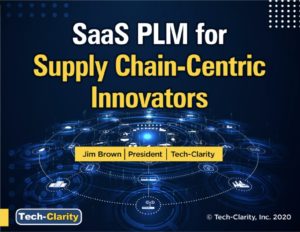As manufacturers look for strategies that will let them remain competitive while navigating increasingly complex supply chains and challenging business environments, many are turning to product lifecycle management (PLM) or product data management (PDM) solutions hosted in the cloud. Choosing a PLM solution isn’t always a straightforward decision: here, we share information about the advantages of cloud PLM and strategies to help you pick the right one.
The Advantages of Cloud PLM
Cloud PLM and cloud PDM are based on the software-as-a-service (SaaS) model, which lets businesses use the internet to access software solutions. These solutions are generally hosted on the cloud, banks of computers hosted in a remote location and maintained by a third party.
While cloud-based SaaS solutions have grown in popularity in recent years, interest surged in 2020, as the world felt the impact of the COVID-19 pandemic. Travel was curtailed, work became remote, and supply chains were disrupted. In response, many companies turned to the lifeline of digital transformation: research by McKinsey suggests that the pandemic has increased the pace of digital acceleration by seven years. Now, cloud-based SaaS solutions in particular are making it possible for businesses to continue to access data, connect with employees, and collaborate with partners and customers.
For manufacturers, the biggest advantages to cloud PLM and cloud PDM are increased agility and reliability: cloud-based solutions typically let businesses get new solutions up and running faster, and with upgrades sent automatically from the cloud to users, downtime is minimized. Cloud-based solutions offer scalability, as improvements and additional features are streamlined and can be installed without disruption. Cloud-based solutions also make it easier for colleagues and partners to collaborate by tracking changes made to data and controlling access to files, ensuring that critical work isn’t mistakenly over-written or worse, removed from secure storage. And because maintenance and security features are enabled by the cloud or are built into the platform, cloud PLM and cloud PDM solutions deliver greater security and minimize risk.
Why PLM Isn’t One Size Fits All
Choosing a PLM solution is a difficult decision. In addition to the requirements of different industries, every company has its own unique characteristics and business objectives. There will always be trade-offs: each cloud PLM solution will have both advantages and drawbacks, and companies will have to consider the relative advantages and drawbacks when making their choice.
Before choosing a cloud PLM solution, however, organizations must assess their own characteristics. Above all, are they engineering-centric, or are they supply chain-centric? Engineering-centric organizations are most often found in industries such as automotive and aerospace, and as their name suggests, they typically do most of their engineering in-house. These companies will likely need a PLM solution that offers CAD integration and that allows for close connections at every stage of the product lifecycle.
Supply chain-centric organizations typically include industries such as consumer goods and electronics, and these companies work with their supplier networks for innovation and product development. Critical PLM features for these companies include real-time supply chain connectivity and the ability to collaborate across and manage a wide range of product data and documentation.
For companies considering adopting cloud PLM, there are other important considerations. While some engineering-centric manufacturers have delayed moving to the cloud because the available PLM solutions don’t offer the functionality they’re looking for, supply chain-centric companies may find that cloud PLM’s enhanced agility outweighs any specific capabilities that might be lacking.
Now, even that gap is rapidly shrinking: many newer cloud PLM solutions have reduced the trade-offs by adding engineering-centric capabilities to their offerings. And while some early SaaS solution providers focused solely on web-based infrastructure, newer, cloud-native SaaS companies offer broader PLM approaches that include training, data migration, integrations, licensing, upgrades, and more.
The future lies with Cloud PLM, and it’s time to find the solution that will drive growth at your business. To learn more, download our eBook, SaaS PLM for Supply Chain-Centric Innovators or click here to learn more about Autodesk’s cloud based PLM and PDM solution, Upchain.


Pingback: How to Improve Supplier Collaboration with Cloud PLM - Under the Hood - All things PDM and PLM